Overclocking Intel Pentium 4 up to 3.6 GHz. Options.
Recently I got into the hands of a very interesting processor - engineered copy of the Intel Pentium 4 3.4GHz. It is based on the D1 stepping Northwood core, it operates at a voltage of 1.55V, however, the most interesting, is it a factor that can vary from x12 to x17.
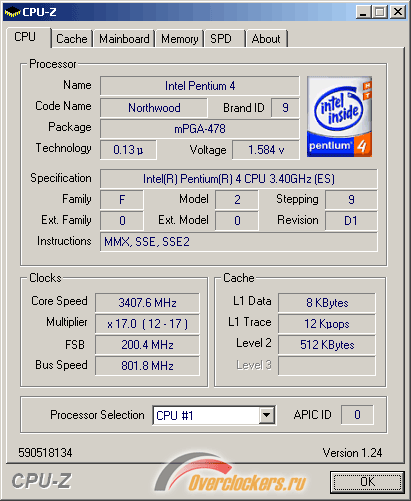
Of course, the first thing I checked the CPU overclocking, but to rise above the frequency of 3.6 GHz, I could not, and we already have the Intel Pentium 4 processor 2.4S, which is capable of operating at this frequency. However, there was a significant difference - our processor passes all game and synthetic tests, but quickly falls out with an error when checking in Prime95. The same processor is properly worked Prime95 on the bus frequency of 300 (1200) MHz with reduced up to x12 multiplier.
Ability to change the multiplier value provides a completely different overclocking options than the processor with a fixed multiplier, and the presence of memory Patriot PDC5123200 + XBLK, which is able to work in a wide range of frequencies up to 285 MHz, gives us even more freedom of choice. The same 3.6 GHz processor speed can be obtained by various combinations of factor and bus frequency, and also at a different frequency memory. As a result, I get the following options:
| Factor | The frequency of the bus | Memory Divider | memory frequency | memory timings |
| 12 | 300 | 3: 2 | 200 | 2.0-2-2-5 |
| 12 | 300 | 5: 4 | 240 | 2.5-3-3-6 |
| 13 | 277 | 1: 1 | 277 | 3.0-4-4-8 |
| 13 | 277 | 5: 4 | 222 | 2.0-3-3-6 |
| 14 | 257 | 1: 1 | 257 | 2.5-3-3-6 |
| 14 | 257 | 5: 4 | 206 | 2.0-2-2-5 |
| 15 | 240 | 1: 1 | 240 | 2.5-3-3-6 |
| 15 | 240 | 5: 4 | 192 | 2.0-2-2-5 |
| 16 | 225 | 1: 1 | 225 | 2.0-3-3-6 |
| 17 | 212 | 1: 1 | 212 | 2.0-3-3-6 |
The test system was as follows:
- Motherboard - Asus P4C800 Deluxe, rev. 1.03, BIOS 1016
- Memory - 2x256 MB Patriot PDC5123200 + XBLK
- Graphics card - PowerColor Radeon X800Pro
- Hard disk - Western Digital WD400PB
- Cooler - Zalman CNPS7000A-Cu
- Thermal Grease - KPT-8
- Power Supply - Thermaltake PurePower HPC-420-302 DF (420W)
- Operating system - WinXP SP2, Catalyst 4.9 (8.07)
However, all is good, clear and understandable was only in theory. The fact that during the tests revealed that at a frequency equal to 3.6 GHz or close to it, the processor is running very unstable: frequent crashes, and some simply can not pass the tests. But there is no problem, if you reduce the FSB only 1 MHz from the estimated. It is in these conditions was carried out a series of tests. In addition, far not been tested all possible frequency ratios and multipliers, but why it happened, why test cycle conceived remained unfinished, once it becomes clear when looking at the summary chart.
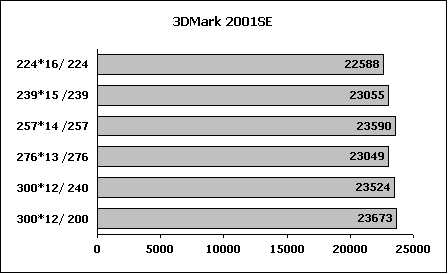


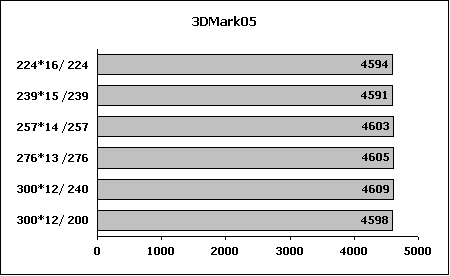
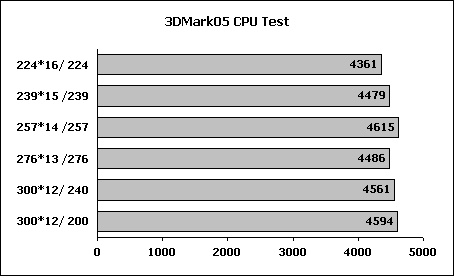
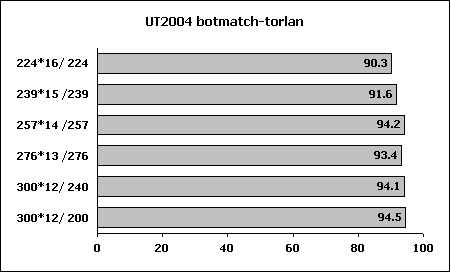
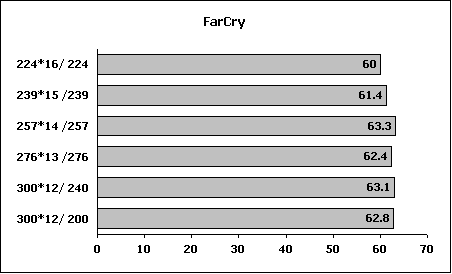
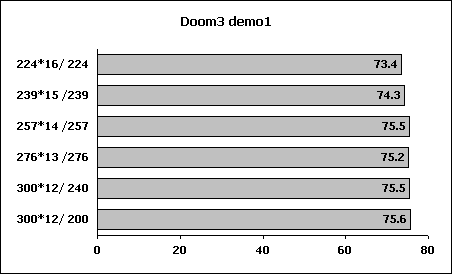
As you can see much of a difference between the options quickly, no system is not looming, so I did not test all possible combinations. Each test was performed at least three times, and each cycle took a very long time. I must say that I still had at least one test for each combination of FSB / multiplier / memory clock, but never found a noticeable difference with the tested variants.
Increasing the frequency of the bus entails an increase in memory frequency and timings forced deterioration in which it operates. If we use step-down dividers for memory timings and leave at the minimum or a sufficiently low values, you lose speed because of asynchrony. It turns out that the most important thing is to overclock the processor, and what it will be a processor almost does not matter, as a result we get approximately the same speed.
However, the positive effect of increasing the FSB has not been canceled, so the options with a large factor, and low frequency of bus do not look very attractive, even if we forget about the cost of older more processors. Separately, you can notice a relatively good option 257 * 14, with synchronous operation of memory. FSB and memory frequency is high enough, and the timing is not too high and the result of several test stands out among his own kind. However, the advantage unobtrusive, moreover, this frequency is not stable working processor and the idea would be necessary to reduce the frequency of 1 MHz, and therefore reduced and results. In short, everything a second time, and the main thing is the acceleration!


Comments
Commenting, keep in mind that the content and the tone of your messages can hurt the feelings of real people, show respect and tolerance to his interlocutors, even if you do not share their opinion, your behavior in terms of freedom of speech and anonymity offered by the Internet, is changing not only virtual, but real world. All comments are hidden from the index, spam control.